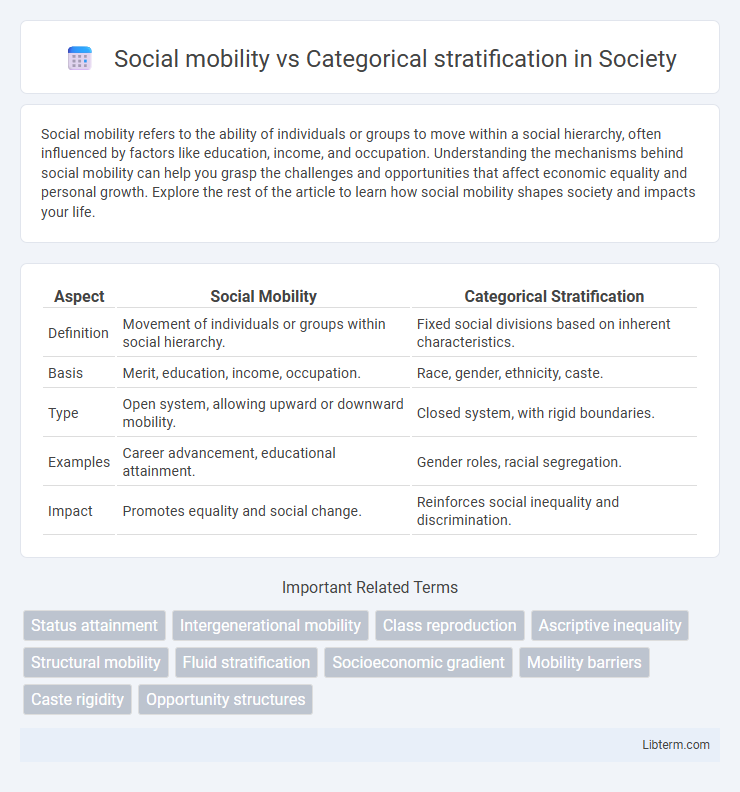Social mobility refers to the ability of individuals or groups to move within a social hierarchy, often influenced by factors like education, income, and occupation. Understanding the mechanisms behind social mobility can help you grasp the challenges and opportunities that affect economic equality and personal growth. Explore the rest of the article to learn how social mobility shapes society and impacts your life.
Table of Comparison
| Aspect | Social Mobility | Categorical Stratification |
|---|---|---|
| Definition | Movement of individuals or groups within social hierarchy. | Fixed social divisions based on inherent characteristics. |
| Basis | Merit, education, income, occupation. | Race, gender, ethnicity, caste. |
| Type | Open system, allowing upward or downward mobility. | Closed system, with rigid boundaries. |
| Examples | Career advancement, educational attainment. | Gender roles, racial segregation. |
| Impact | Promotes equality and social change. | Reinforces social inequality and discrimination. |
Defining Social Mobility
Social mobility refers to the ability of individuals or groups to move within a social hierarchy, typically measured by changes in income, education, or occupational status across generations. It contrasts with categorical stratification, which assigns rigid social positions based on fixed characteristics like race, gender, or caste, limiting upward or downward movement. Understanding social mobility highlights the dynamic nature of social structures and the potential for individuals to alter their socioeconomic status over time.
Understanding Categorical Stratification
Categorical stratification refers to the systematic division of society into distinct groups based on characteristics like race, ethnicity, gender, or social class, which restricts individuals' opportunities and access to resources. This form of stratification creates entrenched social inequalities by limiting upward mobility within rigid social categories. Understanding categorical stratification is essential for analyzing how social structures perpetuate disparities and hinder social mobility across generations.
Historical Context of Social Mobility
Historical context of social mobility reveals how industrialization and urbanization transformed rigid class structures into more fluid socioeconomic hierarchies, enabling greater movement between social strata. Categorical stratification, rooted in race, gender, and ethnicity, often limited access to upward mobility despite economic changes throughout history. The contrast between evolving economic opportunities and persistent social barriers highlights the complexity of social mobility across different historical periods.
Key Factors Influencing Social Mobility
Key factors influencing social mobility include education access, economic opportunities, family background, and social networks. Educational attainment significantly boosts upward mobility by enhancing skills and qualifications essential for higher-paying jobs. Economic policies, labor market structures, and systemic inequalities also shape individual chances, while categorical stratification based on race, gender, and class often restricts mobility by reinforcing social barriers.
Types of Categorical Stratification Systems
Types of categorical stratification systems include class stratification, caste stratification, racial stratification, and gender stratification, each defining distinct social categories with limited mobility. Class stratification is primarily economic, characterized by wealth and income disparities, while caste stratification enforces rigid social divisions based on birth, often seen in traditional societies like India. Racial and gender stratification create systemic inequalities by embedding discrimination and unequal access to resources within social structures.
Social Mobility within Categorical Stratification
Social mobility within categorical stratification highlights the movement of individuals or groups across social categories such as class, race, or gender, reflecting varying degrees of access to opportunities. This concept emphasizes how structural barriers and systemic inequalities embedded in categorical stratification limit upward mobility for marginalized populations. Understanding the interplay between social mobility and categorical stratification is crucial for addressing disparities in education, employment, and income distribution.
Measuring Social Mobility: Indicators and Metrics
Measuring social mobility involves analyzing indicators such as income changes across generations, educational attainment, and occupational shifts to assess an individual's movement within social hierarchies. Metrics like intergenerational income elasticity, percentile rank mobility, and social class transitions provide quantitative data on upward or downward mobility. These measures contrast with categorical stratification, which emphasizes fixed social groups and structural barriers limiting movement between classes.
Barriers to Social Mobility
Barriers to social mobility include structural inequalities such as limited access to quality education, economic disparities, and entrenched social networks that favor categorical stratification based on race, class, and gender. These barriers perpetuate systemic disadvantages by restricting individuals' ability to move upward across social classes. Overcoming categorical stratification requires policies targeting equitable resource distribution and dismantling institutional biases.
Societal Impacts of Stratification
Social mobility enables individuals to change their socio-economic status, fostering a dynamic society where talent and effort can alter life outcomes, while categorical stratification rigidly confines groups based on characteristics such as race, gender, or class, perpetuating inequality. Societal impacts of stratification include reduced access to resources, limited social cohesion, and entrenched disparities in education, healthcare, and employment opportunities. Persistent categorical stratification undermines social justice by creating systemic barriers that hinder marginalized communities from achieving upward mobility.
Policies and Interventions for Enhanced Mobility
Policies aimed at enhancing social mobility often focus on reducing categorical stratification by addressing systemic inequalities related to race, gender, and class through education reform, affirmative action, and equitable economic opportunities. Interventions such as targeted scholarships, mentorship programs, and inclusive workplace practices improve access to resources and promote upward mobility across historically marginalized groups. Measuring the impact of these policies requires longitudinal studies that analyze shifts in income distribution, educational attainment, and occupational status within different social categories.
Social mobility Infographic

 libterm.com
libterm.com